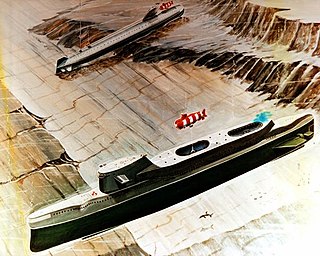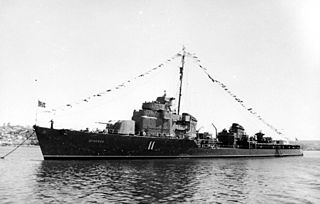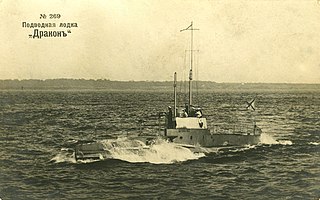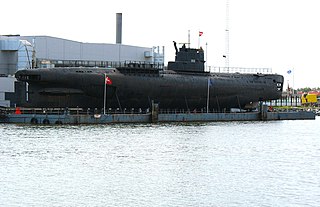
Project 651, known in the West by its NATO reporting name Juliett class, was a class of Soviet diesel-electric submarines armed with cruise missiles. They were designed in the late 1950s to provide the Soviet Navy with a nuclear strike capability against targets along the east coast of the United States and enemy combatants. The head of the design team was Abram Samuilovich Kassatsier. They carried four nuclear-capable cruise missiles with a range of approximately 300 nautical miles (560 km), which could be launched while the submarine was surfaced and moving less than four knots (7.4 km/h). Once surfaced, the first missile could be launched in about five minutes; subsequent missiles would follow within about ten seconds each. Initially, the missiles were the inertially-guided P-5. When submarine-launched ballistic missiles rendered the P-5s obsolescent, they were replaced with the P-6 designed to attack aircraft carriers. A special 10 m2 target guidance radar was built into the forward edge of the sail structure, which opened by rotating. One boat was eventually fitted with the Kasatka satellite downlink for targeting information to support P-500 4K-80 "Bazalt" anti-ship cruise missiles. The Juliett class had a low magnetic signature austenitic steel double hull, covered by two inches (51 mm) thick black tiles made of sound-absorbing hard rubber.

Soviet submarine S-363 was a Soviet Navy Whiskey-class submarine of the Baltic Fleet. Under the designation U137 it ran aground on 27 October 1981 on the south coast of Sweden, approximately 10 km (6.2 mi) from Karlskrona, one of the largest Swedish naval bases. U137 was the unofficial Swedish name for the vessel, as the Soviets then considered names of most of their submarines to be classified and did not disclose them. The ensuing international incident is often referred to as the Whiskey on the rocks incident.

Whiskey-class submarines are a class of diesel-electric attack submarines that the Soviet Union built in the early Cold War period.
Project 1840 is the name of a Soviet diesel-electric research submarine design of which only one vessel was built. The design is known in the west by its NATO reporting name Lima. The submarine, which was assigned hull number БС-555, was completed in 1979, and used by the Black Sea Fleet. It was decommissioned and laid up in 1994. The unarmed vessel was equipped with two diving chambers for deep-sea operations and hydro-acoustic experiments.

The Project 940 Lenok class was a military submarine design of the Soviet Union.

С-178 (S-178) was a Project 613B diesel submarine of the Soviet Navy. On October 21, 1981, in the Sea of Japan, the submarine under the command of Valery Marango was hit by a cargo ship. The collision killed 32 sailors.

S-80 was a diesel-electric submarine of the Soviet Navy.

The Soviet Navy's Project 611 were one of the first Soviet post-Second-World-War attack submarines. They were similarly capable to the American GUPPY fleet-boat conversions. They were a contemporary of the Whiskey-class submarines and shared a similar sonar arrangement. Like most conventional submarines designed 1946–1960, their design was influenced by the German World War II Type XXI U-boat.

The Project 670 Skat submarine was a nuclear-powered cruise missile submarine built for the Soviet Navy and later operated by the Russian Navy. All Charlie I/II-class submarines are decommissioned. One Charlie-class submarine was used for testing an Oniks missile. Charlie I and its successor Charlie II-class submarines are designed by the Lazurit Central Design Bureau of Gorky.

The Ognevoy-class destroyers consisted of 26 destroyers built for the Soviet Navy during and immediately after World War II. The official Soviet designation was Project 30 and Project 30K. Construction was disrupted by the invasion of the Soviet Union in 1941 and many ships were cancelled or scrapped. Only a single ship was completed during the war and the other 10 were finished in 1947–1950.

The Kaiman class were a class of submarines built for the Imperial Russian Navy before World War I. They were designed by Simon Lake and built at the W:m Crichton & C:o Okhta shipyard in Saint Petersburg. The boats had numerous defects resulting in a legal battle between Lake and the Russian Government. The boats were impounded in 1910 and rebuilding work took place to remedy some of the defects. The boats finally commissioned in 1911 and served in the Baltic Fleet.
The S-99 experimental submarine was the only ship of the Project 617 class that the Soviet Union built during the early Cold War. She was the only Soviet submarine which used a German Walter turbine fueled by high-test peroxide (HTP). Entering service in 1956, the boat was assigned to a training unit of the Baltic Fleet. S-99 was badly damaged by a HTP explosion in 1959 and was not repaired. The submarine was decommissioned in 1964 and subsequently scrapped.
The UGM-89 Perseus was a proposed U.S. Navy submarine-launched anti-ship (AShM) and anti-submarine (ASW) cruise missile that was developed under the Submarine Tactical Missile (STAM) project, which was also referred to as the Submarine Anti-ship Weapon System (STAWS). This missile system was to be the centerpiece for a proposed third-generation nuclear-powered cruise missile submarine championed by then-Vice Admiral Hyman G. Rickover, the influential but controversial head of the Navy's nuclear propulsion program.

S-189 is a Project 613B diesel submarine of the Soviet Navy.

ORP Bielik (295) was a Whiskey-class submarine of the Polish Navy during the Cold War. It was one of the four Whiskey-class submarines operated by the Polish Navy, the other three being ORP Orzeł (292), ORP Sokół (293) and ORP Kondor (294). The submarine was launched in the Soviet Union in 1955 where it served as S-279. In 1965 the ship entered Polish service where it served under the pennant number 295, and was active until 1988.

Soviet submarine B-80 was a Project 611 or Zulu-class conventional submarine of the Soviet Navy's Northern Fleet. She was in service during the Cold War, and after de-commissioning was sold in 1991 to private buyers in the Netherlands. She was scrapped in 2019.

Soviet submarine U-359 was a Soviet Whiskey-class submarine built in 1953 and in service until 1993. After decommissioning, it was acquired by a Danish project for unemployed youth interested in turning it into a cultural site and tourist attraction.

K-70 was a "Project 651" diesel–electric submarine built for the Soviet Navy during the 1960s. Commissioned in 1965, the boat was armed with long-range cruise missiles to carry out its mission of destroying American aircraft carriers and bases. The missiles could be fitted with either conventional or nuclear warheads. K-70 was initially assigned to the Northern Fleet, but was transferred to the Pacific Fleet a few months later. The submarine was decommissioned in 1989 and subsequently scrapped.

K-68 was a "Project 651" diesel–electric submarine built for the Soviet Navy during the 1960s. Commissioned in 1965, the boat was armed with long-range cruise missiles to carry out its mission of destroying American aircraft carriers and bases. The missiles could be fitted with either conventional or nuclear warheads. While much of the submarine's activities during the Cold War are unknown, she did make at least one patrol in the Mediterranean Sea before serving as the test bed for an auxiliary nuclear reactor from 1976 to 1991. K-68 was decommissioned in 1992 and subsequently scrapped.

K-85 was a "Project 651" diesel-electric submarine built for the Soviet Navy during the 1960s. Commissioned in 1965, the boat was armed with long-range cruise missiles to carry out its mission of destroying American aircraft carriers and bases. The missiles could be fitted with either conventional or nuclear warheads. While much of the submarine's activities during the Cold War are unknown, she did make at least two patrols in the Mediterranean Sea while assigned to the Northern Fleet. The submarine was renamed B-124 in 1977 and was transferred to the Baltic Fleet four years later. B-124 was decommissioned in 1993 and subsequently scrapped.
























